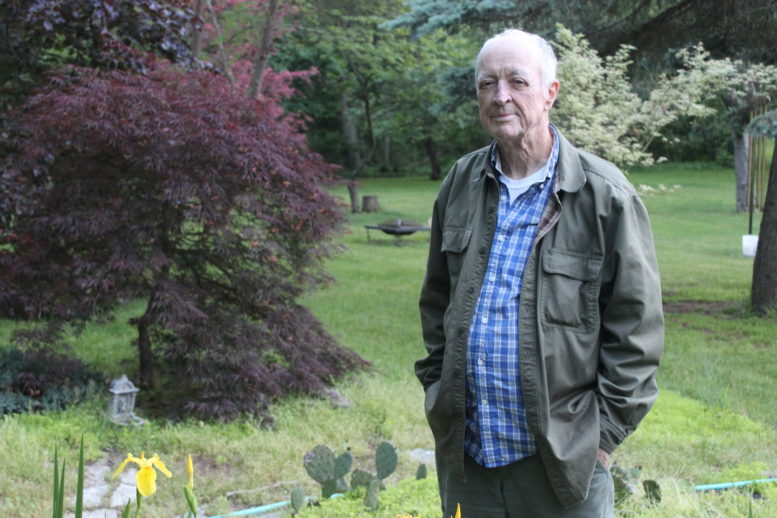By DAVID DUPONT
BG Independent News
Tom McLaughlin was walking in the rain recently.
When a driver stopped and asked if he wanted a ride, McLaughlin declined. He was getting ready for Ireland.
The 82-year-old native of Bowling Green, who made his career elsewhere before returning to his hometown 25 years ago, is on the move again.
At the end of July he’ll begin a long journey, first by train and then by plane, to his new home in Cornamona in Ireland’s County Galway. There he’ll continue his studies in the Irish language, memorize the poetry of William Butler Yeats and soak in the music and dancing. “Wherever they have traditional music, I’ll be there,” he said.
For McLaughlin, it’s a return to a land his family left several generations ago. His late wife Kathleen, who had a keen interest in genealogy, located records of a great grandparent in Pennsylvania.
McLaughlin’s own grandparents lived in Bowling Green where he was born. When he was just about ready to enter high school his parents moved north to Oregon. (He still gets together for lunch with members of the Bowling Green High Class of 1953.)
In September, 2015, McLaughlin, traveled to Ireland with his five grown children. His eldest son, Tom Jr., was suffering from the cancer that would claim him in June, 2016.
Tom Jr .had a deep love of Irish music and dancing, and as a naturalist a fascination with the cliffs and the birds that swirled about them.
They located the ancestral plot in Northern Ireland. They explored the culture and the nature. And they hatched an idea. Why not buy a place in Ireland, with everyone having a stake, where they could visit? A second home in the ancestral homeland. They even considered opening a bed and breakfast.
When McLaughlin returned home, he had more immediate concerns. He had been diagnosed with colon cancer, and his time was occupied caring for Tom Jr.
The idea of the Irish homestead seemed to fade.
Then came the November election, McLaughlin said his son, Bill, a fire chief in Colorado, and McLaughlin’s three daughters, Colleen, Maureen, and Pegeen, came home for Thanksgiving. Bill, McLaughlin said, “couldn’t understand how Trump got elected.”
Now was the time to realize the dream. So McLaughlin and his son flew over in March and found a place, and Tom Sr. negotiated to buy it with the furnishings for no extra costs.
McLaughlin needed to get a visa as “a retired person of independent means.” That meant passing a health assessment. “They don’t want you to be a burden on society.” Doctors found no sign of either the colon cancer or the melanoma.
He was required to show he has an income of at least 50,000 euros a years, or about $50,000. He had to sign up for the national health care, which has no restrictions for preexisting conditions. His police record came back clean.
Now McLaughlin is wrapping up his life in Bowling Green. On June 2, 3 and 4, from 9 a.m. to 5 p.m. each day, an estate sale will be held for the contents of his house at 877 Pearl St. The sale is being run by Shelly Zavaleta of Mainstreet Antiques.
He’s already packed the 44-inch cube he’s allowed to ship over. Some items will be auctioned off at Whalen Auction House, Neapolis.
Everything must go. That includes art work acquired over the years at the Black Swamp Arts Festival.
McLaughlin exhibited his miniature dollhouses, completely furnished with fine crafted furniture, in the first festival in 1993. He won the second place award. First place went to Dorothy Linden.
But he realized “my work was so unusual, it wouldn’t sell.” So he talked to Jacquie Nathan and Kay Baglione, who chaired visual arts, and volunteered to work with them. For the next couple years, he demonstrated his craft in Acts of Art.
He had started creating the miniatures years before by making tiny furniture out of scraps of wood with his three daughters. He found he liked the work and had a knack for it. His work was good enough to be selected for the Toledo Area Artists Exhibition at the Toledo Museum of Art.
When Nathan stepped down, McLaughlin joined Baglione as chair of visual arts, a position he held for a decade.
He praised Baglione and Nathan for their leadership in those early years. “Jacquie was very adamant about the way things should be done.” The jurors were given free rein to select who would be in the juried show based solely on quality.
In 1998, under McLaughlin and Baglione, the festival did away with the non-juried show, and instead created the Wood County Invitational for artists who lived within a 25-mile radius of Bowling Green. After a rough start in the first year when the show was located in the alley behind the Old Millikin hotel, the show has thrived in the parking on the corner of South Main and Clough. It insures area artists have a presence at the show while maintaining the integrity of the juried show.
“We really set up a foundation that really works,” he said.
That included getting involved with Sunshine Artist, the leading journal for the art fair circuit, and the Art Fair Source Book, which helped promote the festival on a national level. The festival began appearing on Sunshine Artist’s list of best shows in the country.
It also meant figuring out a system, with the guidance of Bill Hann, of how to efficiently move artists onto Main Street in the early morning hours of the Saturday of the festival, transforming the street into an outdoor art gallery.
While he has stepped aside from the festival committee, his family’s involvement continued with Tom Jr., who was a member of the performing arts committee, and his granddaughter Lily who works with artist hospitality.
A chemical engineer by training, McLaughlin worked his entire career in New Jersey at the U.S. Armaments Research and Development Center, the “cradle of ammunition,” which dates back to the earliest days of the revolution.
He started there as an Army private and continued after his discharge three years later as a civilian. He ended up as supervisor for the division that took care of logistics, maintenance, field support, technical manuals, and new equipment training.
The work involved miniaturization which was useful when it came to making tiny furnishings.
But, he said, “I didn’t like New Jersey. I got to more and more dislike it. It was too crowded. Too much suburban sprawl.”
When he retired, he and Kathleen were looking for a more congenial place to settle. McLaughlin said he wasn’t interested in moving to Oregon, or any place too close to Toledo, so he and Kathleen decided to take a drive to Bowling Green.
“It was amazing how much the town has not changed,” he said. The Cla-Zel, where his father worked on its opening night in 1926, was still showing movies. “There may be new businesses but the architecture was the same.”
They decided to make their home here. McLaughlin loves the diversity of the community that’s fed by the presence of Bowling Green State University.
“I’ve walked every trail in this town,” he said. “I’ll miss going to the cemetery every Sunday.”
Kathleen died in July, 2014.
Cornamona is smaller with a population of 2,000 with 20 pubs all serving seafood and featuring traditional music. Cornamona also has four art galleries and three working artists – a potter, a glass blower, and a jeweler.
In spring the village hosts a music festival and in September there’s a 10-day arts festival, though because of the weather, it’s a more indoor affair, more like an art walk.
The sea is just a two-mile walk from his home, and in the opposite direction are mountains and a national a park
“I plan,” McLaughlin said “to do a lot of walking.”





